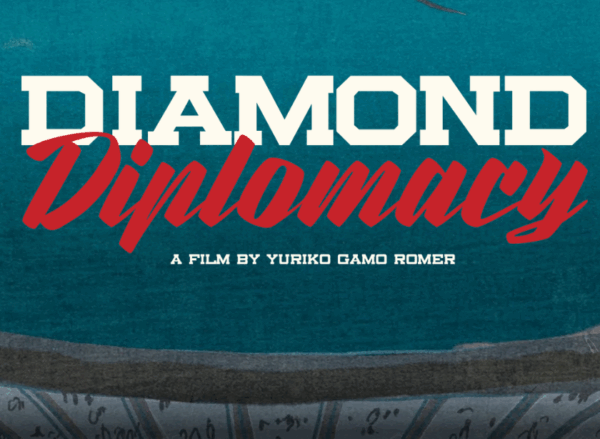 The 48th Mill Valley Film Festival started last Thursday, October 2nd. One of the films I was interested in screening was ‘Diamond Diplomacy:
The 48th Mill Valley Film Festival started last Thursday, October 2nd. One of the films I was interested in screening was ‘Diamond Diplomacy:
“Long considered America’s official pastime, ever since baseball was introduced to Japan in the late 19th century, the sport has become a mutual obsession between the two nations. A key factor in bridging the cultural gap between East and West, baseball has also been used as a way to combat anti-Japanese prejudices in the US from WWII to the present day. Documentarian Yuriko Gamo Romer (Mrs. Judo: Be Strong, Be Gentle, Be Beautiful) traces the long, shared history behind our mutual love of the old ballgame, from Japan’s embrace of Black players in the 1930s to Babe Ruth, Lou Gehrig, and their fellow all-stars playing exhibition games overseas to the era of contemporary MLB heavy hitters like Ichiro Suzuki, Hideo Nomo, and (of course) Shohei Ohtani. Diamond Diplomacy is a fascinating and definitive look at how nine innings changed the way two countries communicate across a great divide. Play ball!”
Unfortunately, I couldn’t see the world premiere of the documentary in person but was able to watch an online screener. You might think I am a huge baseball fan, but I’m not actually. At best, I am a very fair weather fan of the Boston Red Sox and San Francisco Giants. Still, understanding Japan motivates me. This movie taught me a lot about the connection between the United States and Japan, especially about the mutual long standing love for the game of baseball.
Initially, I just assumed that the Japanese learned about baseball after the U.S. occupation of Japan after World War II. The first origins of modern baseball as we know it today was around 1845. An American professor introduced baseball to Japan in 1872, a few years after the Meiji Restoration period started:
“Baseball … is as ingrained in Japanese culture as the national pastime is in America. The game was introduced there in 1872 by American professor Horace Wilson, who taught it to his students at Kaisei Academy in Arakawa, Tokyo. In the century and a half since, it’s become the country’s most popular sport.
A seminal moment for Japanese baseball came in 1934: Yomiuri Shimbun president Matsutaro Shoriki organized a Japanese baseball all-star team that helped the sport take off. That year, Babe Ruth, Lou Gehrig and Jimmie Foxx arrived in Tokyo, leading an American all-star team of MLB legends on a tour of Japan, where they played a series of exhibitions against the All-Nippon team. Ruth & Co. brought a huge turnout from Japanese fans, and when the tour was over, Shoriki kept his all-star team together as the Great Japan Tokyo Baseball Club. That team would become the Yomiuri Giants.
Two years later, in 1936, Japan’s first professional league formed with seven teams, including Shoriki’s club. By 1950, it had grown to the point that it needed to reorganize into two leagues — the Central League and the Pacific League — under one name: Nippon Professional Baseball.
In the present day, NPB is widely recognized as the world’s top baseball league outside of MLB. Baseball is an institution in Japan at every level, from the youth teams that routinely win the Little League World Series to the legendary summer Koshien high-school tournaments to the hugely popular NPB to the Japanese stars who jump to the Major Leagues.”
The documentary shows footage artifacts, photos, film of the early era of baseball in Japan as well as the historical context. Seeing the footage of Babe Ruth, Lou Gehrig and Jimmie Foxx on their first trip to Japan and seeing the Japanese public’s interest in the American ball players was incredible.
The documentary also discusses the eras of the emergence of the Japanese American leagues and the bombing of Pearl Harbor. It covers the ensuing incarceration of Japanese Americans in concentration camps, the occupation of Japan by the United States after the war, and how baseball was a cultural connection that helped reunify former enemies. Along the way, Diamond Diplomacy interviews many Japanese and Japanese Americans of that time about what baseball meant to them.
To my surprise, the first Japanese baseball player to play in the U.S. Major League Baseball league was Masanori Murakami – for the San Francisco Giants:
“Thirty-seven years before Ichiro, there was Masanori Murakami — the first Japanese player in Major League Baseball history, who played alongside Willie Mays, struck out Hank Aaron and … bunted for a hit against Sandy Koufax?
Yes, Murakami, a left-handed pitcher who played two seasons for the Giants in 1964 and ’65, has some legendary stories from his time in the Major Leagues. And he recounted the best of them last week in New York, on his way back from Ichiro’s Hall of Fame induction ceremony in Cooperstown.”
Murakami is still alive. The documentary interviews him and discusses his time playing in the United States. It profiles of the Japanese baseball players that followed him, including the most recent and arguably the most talented, Shohei Ohtani. The documentary also profiles American ballplayers playing overseas in Japan.
Even if you’re not a fan of baseball, you might still enjoy learning how the history between Japan and the United States has been connected through the game of baseball. I certainly did. Diamond Diplomacy makes a convincing case that the game has been a vital factor in bringing our two countries closer.
As far as seeing the documentary, the film is still making the film festival route. You can check out more details on screenings on the film’s website here.








